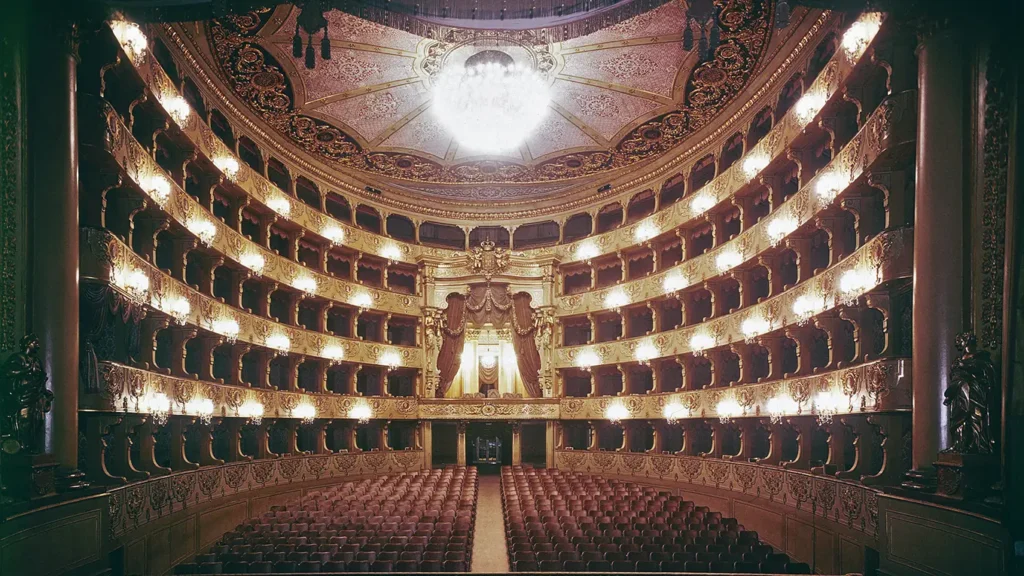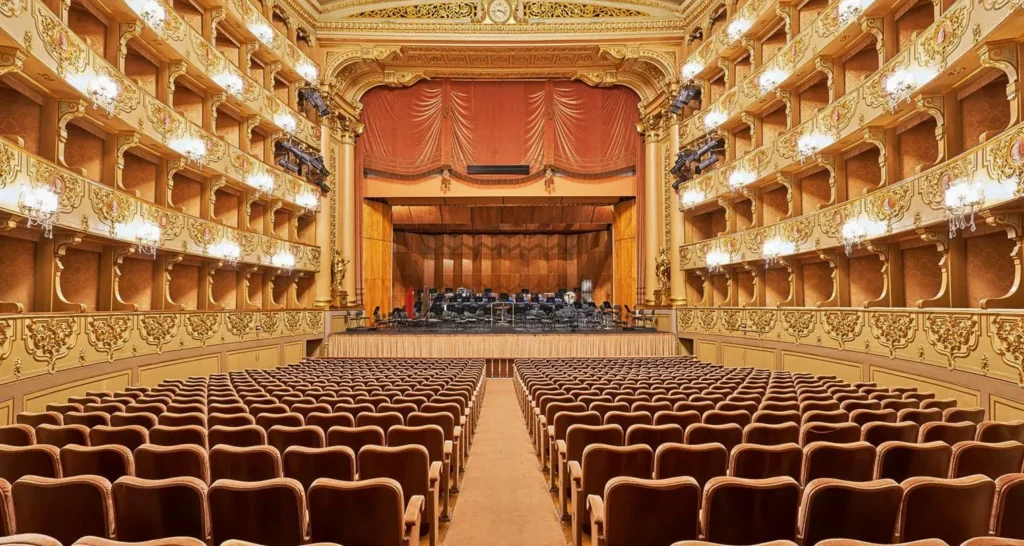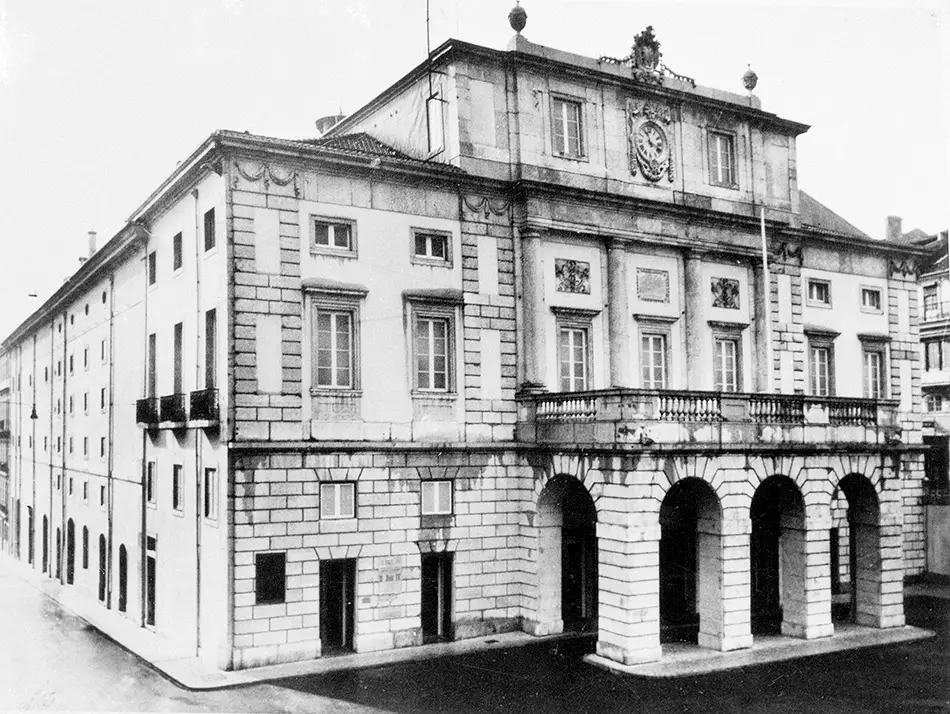Lisbon, a city steeped in history and brimming with culture, offers a treasure trove of experiences for the discerning traveller. Among its many gems lies the São Carlos National Theatre, a magnificent opera house that has captivated audiences for over two centuries. Whether you’re an expat seeking a taste of European high culture or a tourist eager to explore Lisbon’s vibrant cultural scene, the São Carlos National Theatre promises an unforgettable experience.
A Glimpse into History
The São Carlos National Theatre stands as a testament to Lisbon’s resilience and enduring passion for the arts. Its story is interwoven with the fate of its predecessor, the Ópera do Tejo. The Ópera do Tejo, inaugurated in 1755, was meant to be the city’s main opera house but was tragically destroyed by the devastating Lisbon earthquake just seven months later. This catastrophic event, which reshaped Lisbon’s landscape and history, created the need for a new cultural centre, leading to the construction of the São Carlos National Theatre.
Rising from the ashes of tragedy, the São Carlos National Theatre opened its doors on June 30, 1793, thanks to the vision of Queen Maria I. The theatre’s name honours Princess Charlotte of Spain, wife of the future King John VI of Portugal.
In the early 19th century, when the Portuguese Royal Court sought refuge in Brazil to escape the invading Napoleonic troops, they carried this architectural inspiration with them, leading to the construction of a theatre modelled after the São Carlos in Rio de Janeiro. This demonstrates the significant impact of the São Carlos on architectural and cultural trends beyond Portugal’s borders.
The theatre’s neoclassical design, inspired by iconic Italian opera houses like La Scala in Milan, was brought to life by Portuguese architect José da Costa e Silva. The first opera to grace its stage in 1793 was Domenico Cimarosa’s “La Ballerina Amante.” Adding to its prestige, Marcos Portugal, the most celebrated Portuguese composer of the time, became the musical director of the São Carlos in 1800 after his return from Italy, and many of his operas premiered within its walls.
Architectural Splendour
The São Carlos National Theatre is an architectural gem, a harmonious blend of neoclassical and rococo styles. Its façade, a testament to neoclassical grandeur, is adorned with six majestic Ionic columns supporting a triangular pediment. The building’s exterior exudes an elegant simplicity, its balanced proportions and clean lines reflecting the neoclassical aesthetic.

Stepping inside, you’re enveloped in an atmosphere of opulence. The horseshoe-shaped auditorium, richly decorated in gold, blue, and ivory, creates an ambiance of luxury and boasts exceptional acoustics. The concert hall, with its ostentatious aristocratic atmosphere, was decorated by Giovanni Appianni, and the ceiling features exquisite paintings by Manuel da Costa and Cirilo Wolkmar Machado.

The theatre’s design is not just about aesthetics; it’s a carefully orchestrated symphony of architectural elements. The building is longitudinal and composite, with articulated parts and a sober facade. The frontispiece is divided into three distinct levels: two floors on a mezzanine and a third floor crowning the central body. This central body is marked by a portico, serving as the entrance hall, and features a ground-level loggia composed of three frontal arches and a lateral arch, all perfectly rounded. Above the loggia, a terrace with a balustrade in stonework adds to the architectural rhythm. The windows, framed by parastase that support a highlighted cornice, are crowned by panels with inscriptions and two high reliefs, adding intricate detail to the facade.

The theatre has undergone several renovations throughout its history, the most significant of which took place in the early 20th century. These renovations have ensured the preservation of its historical charm while adapting to the needs of modern audiences. In 1928, the São Carlos National Theatre was officially recognized for its architectural and cultural significance, being classified as a National Monument.
A Cultural Hub
The São Carlos National Theatre has been a vibrant hub of artistic expression for over two centuries. It quickly established itself as a centre for Italian opera, attracting renowned artists and composers. The theatre played a pivotal role in introducing Romanticism to Portugal and has consistently maintained its reputation as a premier opera house.
Throughout its history, the São Carlos has demonstrated remarkable resilience, surviving not only the initial destruction of its predecessor but also a period of closure during the Portuguese Civil War between 1828 and 1834. In 1850, the theatre embraced technological advancements by switching to gas illumination, and shortly after, it was acquired by the Portuguese state from private investors. Further modernization came in 1887 with the installation of electrical illumination, after a few initial setbacks. Even a period of closure for repairs from 1935 to 1940 couldn’t diminish its spirit.
In 1974, the theatre further solidified its commitment to opera by establishing a resident opera company. The São Carlos continues to adapt and evolve, embracing modern trends and incorporating contemporary operas and ballets into its repertoire. It stands as a cultural ambassador for Portugal, showcasing both traditional and contemporary works, and highlighting the country’s rich artistic heritage. As the only Portuguese theatre devoted to producing and presenting opera, choral and symphonic music, it holds a unique position in the nation’s cultural landscape. The São Carlos National Theatre embodies the ‘Italian’ tradition of organization, reflecting the influence of Italian opera houses on its design and artistic direction.
Experiencing the Magic
The São Carlos National Theatre offers a variety of ways to immerse yourself in its magic. Attending a performance is an absolute must, allowing you to experience the theatre’s exceptional acoustics and elegant ambiance. The theatre is home to the Portuguese Symphonic Orchestra, founded in 1993, and the Choir of the Teatro Nacional de São Carlos, the country’s only professional choir, formed in 1943. You can choose from operas, ballets, classical concerts, and a variety of other shows.
The theatre provides three distinct spaces for performances, each offering a unique experience:
| Space | Use |
|---|---|
| Main Hall (Sala Principal) | Grand lyrical productions, symphonic concerts, and ballets |
| Grand Hall (Salão Nobre) | Recitals, chamber opera, music conferences, and opera readings |
| Foyer | Informal chamber concerts and short recitals |
For a more intimate experience, consider attending a performance in the Grand Hall, which hosts recitals, chamber opera, and music conferences. The theatre also organizes the Festival ao Largo, an open-air festival held in São Carlos Square during the summer months, typically in late July. This festival features a diverse range of performances, including opera, theatre, symphonic music, and dance, all with free admittance.
Beyond performances, the São Carlos National Theatre offers guided tours that provide a deeper understanding of its history, architecture, and backstage workings. These tours offer insights into the theatre’s past, its restoration efforts, and its ongoing role in Lisbon’s cultural scene. You can learn about the challenges it has overcome, the architectural influences that shaped its design, and the dedication to the arts that it represents.
The São Carlos also actively engages with the community by promoting and hosting meetings, conferences, master classes, courses, and concerts specifically designed for schools and families. This commitment to education and accessibility ensures that the theatre remains a vibrant cultural centre for all.
Tips for Expats and Tourists
- Plan your visit: Check the theatre’s official website (http://www.saocarlos.pt/) for the latest performance schedule and to book tickets in advance, especially during peak season.
- Take a guided tour: To delve deeper into the theatre’s history and architecture, consider taking a guided tour. These tours often provide access to areas not usually open to the public, offering a behind-the-scenes glimpse into this historical gem.
- Explore the Chiado district: The theatre is located in the charming Chiado district, known for its historic buildings, shops, and cafés. Take some time to explore the area before or after your visit, perhaps enjoying a traditional Portuguese meal or browsing the unique boutiques.
- Dress accordingly: While there is no strict dress code, it’s always a good idea to dress respectfully when attending a performance. This shows appreciation for the artists and the historical significance of the venue.
- Enjoy the ambiance: Soak in the atmosphere of this historic venue, imagine the echoes of past performances, and appreciate the dedication to the arts that it represents.
Conclusion
The Teatro Nacional de São Carlos is more than just an opera house; it’s a living testament to Lisbon’s enduring passion for the arts and a symbol of the city’s resilience. With its rich history, architectural splendour, and world-class performances, it offers an experience that will resonate with American expats and tourists alike.
For expats, the São Carlos provides a taste of European high culture and a connection to the grand opera houses of Europe. Its architectural style, reminiscent of iconic Italian theatres, will evoke a sense of familiarity, while the diverse program offers a chance to experience both classic and contemporary works.
Tourists will be captivated by the theatre’s historical significance, its role in Lisbon’s cultural landscape, and the opportunity to witness authentic Portuguese artistic expression. The São Carlos offers a glimpse into the soul of Lisbon, showcasing the city’s vibrant artistic heritage and its dedication to preserving tradition while embracing innovation.
As you plan your trip to Lisbon, be sure to include this cultural gem in your itinerary. Whether you choose to attend a performance, take a guided tour, or simply admire its architectural beauty, the Teatro Nacional de São Carlos promises an unforgettable experience.




